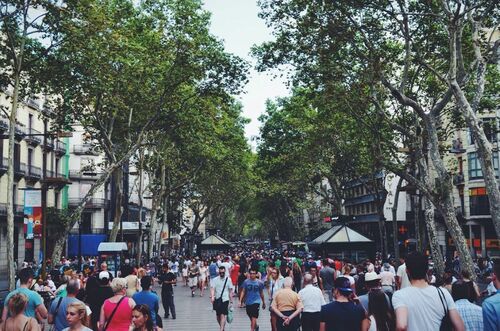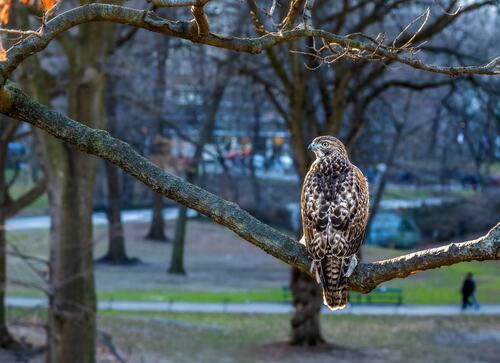Urban Trees: Nature’s Skyscrapers for City Wildlife
Introduction
Did you know that the trees on your street are secret homes for animals? It’s true! In 2024, city trees are more important than ever for animals living in towns and cities. A new study found that one big oak tree can be home to up to 2,300 different kinds of living things—that’s like a whole world of nature right outside your window!
Let’s explore the amazing world of city trees and see how they’ve become like tall natural buildings for animals. From birds and squirrels to bugs and even bats, you’ll be surprised at all the life hiding in our cities!
The Rise of Urban Forests: From Decoration to Ecosystem

A Crowded Street Lined with Trees – Photo by Pavlo Luchkovski
Once upon a time, city trees were mainly planted for their aesthetics. But oh, how times have changed! In the last few years, we’ve learned that trees are much more than just pretty green things—they’re very important for our cities.
People who plan cities and study nature now know that trees are a big part of city life. They have a lot of benefits besides just looking pretty. From improving air quality to cooling the city down, trees make our cities better places to live—for people and animals!
Wildlife That Calls Urban Trees Home
To truly appreciate the wildlife in our cities, we first need to understand the concept of urban forests. But what exactly is an urban forest? Let’s take a quick journey through time to find out!
What is an Urban Forest?
The concept of urban forests has evolved significantly over time. In ancient Rome, trees lined important roads and public spaces, serving mainly as decoration. Fast-forward to the 19th century, and we see the birth of the “City Beautiful” movement, where trees were used to soften the harsh lines of cities.
However, our understanding has grown far beyond aesthetics. Today, people who study nature and plan cities know that trees in parks, along streets, or in yards make up a complex living system right under our noses. This network of trees and other vegetation within an urban area is what we call an ” urban forest .”
How are Urban Forests Important?
Urban forests are now as important to a city as roads or water systems. They’re not just nice to have—they’re necessary! These green networks help manage stormwater, reduce air pollution, and even lower energy costs by providing shade. They work hard to make our cities better places to live!
Beyond these practical benefits, urban forests significantly improve our physical and mental health and increase property values. Most importantly for our discussion, they provide essential habitats for wildlife, turning our cities into places full of life.
How Trees Support Biodiversity

A Squirrel Hiding in a Tree Cavity – Photo by TheOtherKev
Urban trees are amazing at supporting many kinds of life . They’re like nature’s apartment complexes, cafeterias, and highways for city wildlife. Natural cavities and hollows in trees make cozy homes for many creatures. Owls might nest in higher cavities, while squirrels make their homes in midlevel hollows.
The leaves, bark, and branches of trees are bustling insect habitats. Caterpillars munch on leaves, beetles burrow into bark, and butterflies perch on branches. All these insects then attract birds and other animals that eat them, creating a busy mini-world of nature.
Trees also provide food for city animals with their fruits, nuts, and seeds. Acorns from oak trees feed squirrels and jays, while berries attract many kinds of birds. This food is especially important during cold winters when other food is hard to find.
In the city, trees act as paths for animals to move around on. Connected treetops let animals travel above busy streets, while lines of trees make safe “green paths” through the city. Even single trees can help animals move between bigger green areas.
By doing all these things, city trees play a big part in keeping many kinds of life in our cities, making sure that our cities remain vibrant ecosystems teeming with life.
The Challenges of Urban Wildlife Habitats

Baby Birds in a Nest
Even though city trees provide important homes for animals, the animals still face many problems in city environments. These problems affect not just the trees but also the many animals that depend on them to live.
Pollution
Pollution is a big threat to city forests and the animals living in them. Air pollution damages leaves and weakens trees, making them more susceptible to disease and pests. This doesn’t just hurt the trees but also the animals that need the trees for food and shelter. When trees have trouble growing in polluted places, all the animals in the city feel the effects.
Climate Change
Climate change is another big problem for city forests and their animal residents. Higher temperatures and changes in rain patterns stress trees, which can change when leaves grow and fruits appear. This can cause problems for animals, changing when they can find food and have babies. As the weather keeps changing, both trees and animals must learn to live in our changing cities.
Human-Animal Conflicts
As animals get used to living in cities, they sometimes have problems with people. While many people like seeing animals in cities, others think of them as pests, which can cause arguments about space and resources. Finding ways for people and animals to live together peacefully is a big challenge for city planners and people who live in cities, but it’s important for keeping our city ecosystems healthy.
Invasive Species
Invasive species are another danger to city ecosystems. These newcomers can sometimes beat out local species, changing habitats and food chains. This can be especially bad in cities where ecosystems are already stressed by human activities. When invasive species take over, they can greatly change the mix of plants and animals in city forests.
Enhancing Urban Trees for Wildlife

A Raccoon Peeking from Behind a Tree
Even with these challenges, there are many ways we can make city trees better for animals. By using smart strategies and getting communities involved, we can create thriving city ecosystems that are good for both people and animals.
Creating animal-friendly cities starts with smart tree care . Good ways to plant and take care of city trees include choosing local tree types, making sure trees have enough space, and trimming trees regularly to keep them healthy. These efforts not only help the trees but also make better homes for animals, creating a strong base for many kinds of life in the city.
Making cities friendly for animals goes beyond just trees. Adding different kinds of plants, creating layers of plants, and leaving some areas “wild” can greatly increase the number of animal species. Simple actions like putting out bird baths or leaving fallen leaves can make city spaces more welcoming to various creatures. By thinking about all parts of our city’s green spaces, we can create rich, diverse habitats right in the middle of our cities.
Community projects play a big role in supporting city animals. Local tree-planting events, projects where people help count and study animals, and programs that teach about city ecosystems can make residents feel responsible for nature. These efforts help create a citywide network of animal-friendly spaces, connecting people with nature and building support for protecting animals.
City planning is key to promoting many kinds of life. Rules that protect existing trees, require green spaces in new buildings, and create safe paths for animals can have a big impact. By including goals for animal life in city planning, we can create city environments where both people and animals can thrive, ensuring a sustainable future for our cities.
The Future of Urban Trees as Wildlife Habitats

An Owl Using a Tree Cavity to Nest – Photo by Saketh Upadhya
As we look to the future, the role of city trees as homes for animals is set to grow and change. New ideas and technologies are opening exciting possibilities for animals in cities.
City spaces are changing to better welcome animals, with new designs, like gardens on walls and roofs, creating homes for animals in unexpected places. These creative solutions help many kinds of animals live in crowded areas, turning buildings into extensions of the city forest. Imagine tall buildings covered in plants, providing homes for birds and insects high above the city streets!
Technology is changing how we protect city animals. Smart sensors and cameras powered by artificial intelligence help count animals and check tree health, allowing for better and more focused protection efforts. Apps that let regular people help collect information are getting residents involved in studying city nature. These tech tools are helping us understand and protect city animals better than ever before.
Finding a balance between what people need and what animals need is still a big challenge. Future city planning will likely focus on creating spaces that work for both people and animals. This might include parks that are good for animals and help control flooding, or green paths that animals can use that also work as bike lanes. By finding creative ways to meet many needs at once, we can create cities that are better for people to live in and more welcoming to animals.
Looking ahead, we might see many more kinds of animals in cities. As cities focus more on green spaces and residents get more involved in protecting nature, urban areas might become surprising hotspots for many types of plants and animals. The city of the future might not just be smart—it could be wild, too, with thriving ecosystems smoothly mixed into city life.
Conclusion

A Hawk Perched in an Urban Tree
As we’ve seen, city trees are so much more than just green decorations for our cities—they’re lifelines for countless kinds of animals that have learned to live in the concrete jungle. From the tiniest bugs to big birds of prey, these leafy skyscrapers provide food, homes, and a chance for nature to thrive alongside the busy city life.
But here’s the important part: We can’t take our city forests for granted. It’s up to us—yes, you and me!—to protect and care for these vital ecosystems. The challenges are big, from pollution and climate change to conflicts between humans and animals and problems with invasive species. But with new approaches to city planning, community involvement , and technological solutions, we have the power to create cities that are truly safe places for many kinds of life.
So, next time you walk past a street tree, take a moment to appreciate the hidden world it supports. Listen for the chirping of birds, watch for the quick movements of squirrels, and marvel at the complex web of life thriving right before your eyes. Even better, why not get involved in local tree planting or nature protection efforts? Every action, no matter how small, helps keep our city ecosystems healthy.
Together, we can make sure that our cities endure not just as homes for humans but as vibrant habitats for all kinds of wonderful animals. Let’s embrace the wild side of city life and keep our concrete jungles full of many kinds of life. After all, a city that’s good for animals is a city that’s good for all of us. Let’s keep our urban jungles wild!
For help with selecting, planting, and caring for your urban trees, contact Arborist Now today!


